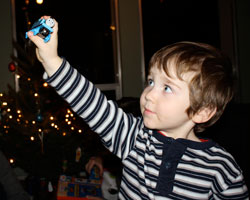Amtrak, Meet Thomas
 Photos by David Adams
Photos by David AdamsDoes the Toy Juggernaut Bode Well for the Future of Rail?
May 7 was National Train Day, an Amtrak-sponsored holiday on which rail enthusiasts gather to geek out on signals and switches, club cars and coal tenders. My three-year old son Simon has more than a passing fondness for railroads, inspired by the omnipresent Thomas and Friends. So we headed to Chicago’s Union Station to catch a glimpse of rail’s past and, just maybe, its fleet future.
This year’s festivities had particular significance because they marked Amtrak’s 40th anniversary. If the rail service is to survive another 40, it must find ways to draw more passengers and increase revenues. More than a few folks think that creating high-speed lines can do the trick—while helping cut carbon emissions and take cars off the road.
Global warming seemed far from the minds of the people crowded amid the grand fluted columns of the station’s sky-lit waiting room. If anything, they had come for a sooty taste of railroading’s good old days. Along the tracks we saw classic cars from the Illinois Central and Union Pacific. It took nearly an hour for us to queue through the Hiawatha 261, a vintage train that connected Chicago with St. Paul. Instead of shuttling travelers, it now takes people on pleasure rides replete with chef service. Romantic, perhaps, but hardly a venture that will save any polar bears.

Like many of the traditionalists in the station, identifiable by their striped engineer’s caps, my boy Simon has a taste for antique trains. His beloved Thomas, a cheery blue steam engine, dates to the same era as the 261.
Yet Simon quickly warmed to the modern trains on display. He loved the fold-down bunks in the just-renovated “Superliner” we toured. So did I; The cozy cabins proved nicer than many motel rooms I have slept in.
Simon also loved the punch-and-fold model of an Acela engine provided by Amtrak. He had no idea, of course, that the Washington-to-Boston service represents the one place in the country where high-speed rail has taken hold. He just liked the looks of the thing. Even as a paper model, the Acela was sleek and high tech. The model train sets we saw in action drove home the contrast. On them, the steam engines chuffed and puffed real smoke—but the model Acela whizzed by them with ease.
High-Speed Dreaming
Unfortunately, real high-speed trains will not arrive in Chicago anytime soon. The economic stimulus of 2008 invested $8 billion in bringing high-speed rail to traffic-choked corridors around the country, including projects in California, Michigan, Wisconsin, and North Carolina. Even so, it may be decades before these lines start operating. Simon may be a man before a bullet train finally pulls into Chicago.
In Union Station, I saw lots of parents with kids under 10, many of them certainly Thomas-lovers. Maybe it was the paternal optimist in me, but I couldn’t help but wonder if there might be a cross-pollination between the old and new generations. After all, little smiling Thomas the Tank Engine has been the most popular toy among preschoolers for 10 years now. Surely all that passionate play will have some kind of impact.
When Simon’s generation comes of age, will its ersatz passion for Thomas beget a love for—and reliance on—rail transportation? Could Thomas and Friends save Amtrak?
In the meantime, we are not going to wait on the bullet trains to arrive. Inspired by National Train Day, we are booking tickets to ride the rails to New England this summer.

